Notre-Dame de Paris- History, Architecture and Tips for Visiting
Purchases made through links earn us a small commission, at no extra cost to you.
On a small island in the Seine river, you will find the world famous Notre-Dame Cathedral, its towers reaching up to Heaven from the heart of Paris.

It’s a cathedral that should be included in every Paris itinerary, especially if it’s your first trip to Paris. I have visited Notre-Dame three times now and still feel like if I went back again I would discover something new, appreciate things that I had maybe overlooked.
Notre-Dame is not just a site of worship- it’s a place with a rich history and significant architectural achievements. Thousands of years after its construction, people still travel the world over to marvel at its beauty.
Update: On April 15, 2019, Notre-Dame Cathedral caught fire. Much of the cathedral, which was undergoing restoration work at the time, was destroyed. The ceiling and spire collapsed, but thankfully the façade and towers were saved. The cathedral was rebuilt and reopened to visitors in December 2024. I haven’t visited the cathedral since it was rebuilt so it may not look as described here.
History of Notre-Dame de Paris
In 1160, Bishop Maurice de Sully ordered the demolition of Paris’ previous cathedral, St. Stephen’s. Three years later construction of a new cathedral, Notre-Dame de Paris began.

Bishop de Sully devoted his life, and much of his wealth, to the creation of “Our Lady of Paris”. It was a construction that would continue for many years after his death in 1196. Four different architects worked on the cathedral throughout its construction period. It was the fourth architect that oversaw the completion of the west facade and its rose window in 1225. By 1250 the western towers and North Rose Window were completed and the remaining elements were put in place by 1345.
The church was significantly damaged by revolutionaries in 1792, when many large statues and cathedral portals were destroyed. In 1845 an extensive restoration program began, led by architects Antoine Lassus and Eugene Viollet-le-Duc. The restoration would take 25 years before it was completed.

Architecture of Notre-Dame de Paris
Notre-Dame is widely considered to be one of the finest examples of French Gothic architecture. It was one of the first buildings in the world to incorporate flying buttresses as a means of supporting exterior walls. Many small statues, all individually crafted, can be seen around the exterior of the building. Some statues were used as column supports and others, such as the famous gargoyles, as water spouts. The three large rosettes are regarded as one of the greatest masterpieces of Christianity.
The West Facade
The imposing west facade has been called everything from “a masterpiece of composition and execution,” by Marcel Aubert to “a pure creation of the spirit” by Le Corbusier. It’s simple yet complex, contrasting yet harmonious.
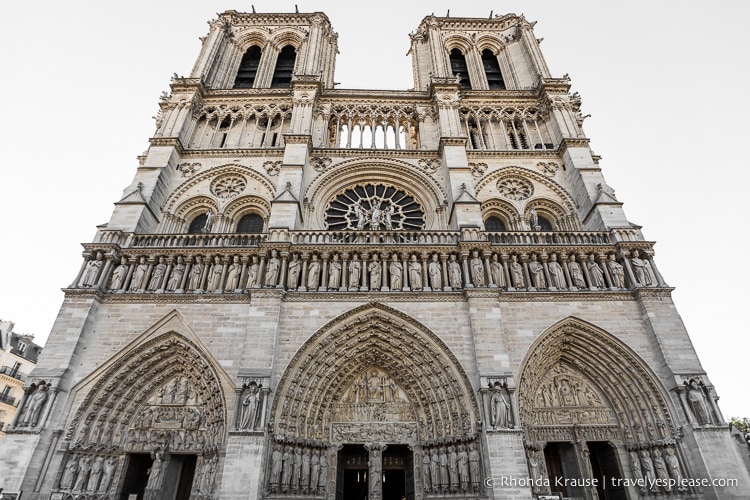
The west facade spans 41 metres wide and rises up 63 metres to the top of the towers. The centre displays a large rose, 9.6 metres in diameter, that forms a halo above a statue of the Virgin with Child. On each side of the Virgin stand two angels.
Underneath the balustrade is the Gallery of Kings. This row of 28 statues represents twenty-eight generations of Kings of Judah.
On the lower level, there are four buttresses each with a niche that houses a statue. The north buttress portrays St. Stephen, the south, St. Denis. The two side buttresses portray allegories of the Synagogue and the Church.
In between the buttresses are three large portals, each one different than the next. The right/south portal is called the Portal of St. Anne. The left/north portal is the Portal of the Virgin and is topped by a triangular gable. The central portal, the Portal of the Last Judgement is the tallest and widest of the three.
Portal of the Last Judgement
The Portal of the Last Judgement is rich in symbolism and tells quite the interesting story. Luckily, we had a guide who could explain it all to us.

To make it easier to understand, I’ll first explain some architectural terms. A “lintel” is ornamented structural item often found over portals, doors and window. A “tympanum” is a semi-circular or triangular decorative wall surface over an entrance, bounded by a lintel and arch. And lastly, “archivolts” are ornamental moldings or bands following the underside curve of an arch.
The lower lintel shows the dead being revived from their graves. On the upper lintel, archangel Michael is weighing their souls. The chosen people, who showed love to God and fellow man, are led towards Heaven on the left. The condemned are led by a devil to hell on the right. Above all this you can see the tympanum, with Christ majestically seated on his throne of glory.
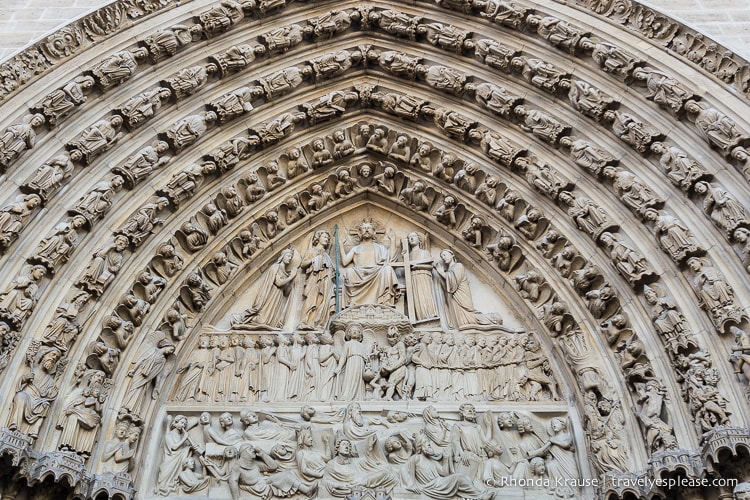
Above Christ, on the archivolts, are figures of the Heavenly Court. Angels, patriarchs, prophets, martyrs, virgins and church doctors are all represented with Hell taking up a small space at the right.

The Rose Windows
The North Rose Window was built between 1250-1260. Its diameter is 12.9 meters (as is the South Rose Window). The centre oculus features Mary holding the Christ Child. Surrounding them are images of kings and prophets of the Old Testament.
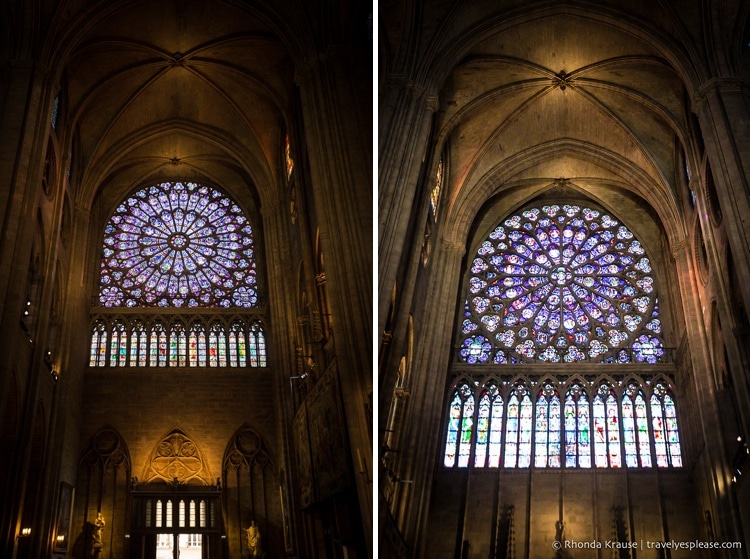
The South Rose Window was built in 1260 as a counterpoint to the North Rose Window. It was a gift from King St. Louis. Its 84 panes are divided into four circles and is dedicated to the New Testament.
The Organs
There are three organs in Notre- Dame Cathedral, the most famous being the Great Organ. With 8,000 pipes and five keyboards, it’s the largest organ in France.

The Spire
Notre-Dame’s original spire, which was also a bell tower, was taken down from 1786-1792. During Viollet-le-Duc’s restoration, he decided to build a second spire which was modelled after the spire built in Orleans in 1852. It’s adorned with copper statues of the 12 Apostles. Viollet-le-Duc actually included himself in the mix, representing himself as St. Thomas.
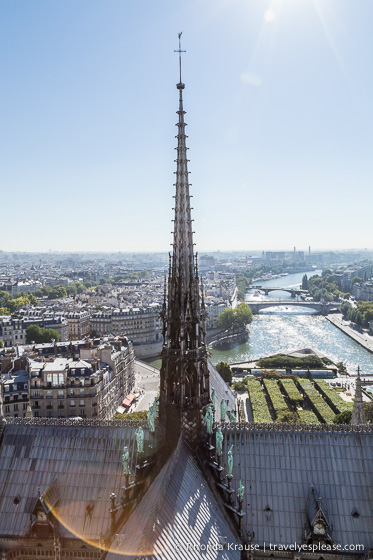
The Gargoyles
My favourite part of Notre-Dame is the gargoyles. You can get an up close view of the famous gargoyles, which were designed as water spouts, by climbing 387 steps to the top of the bell towers. The climb up the spiral staircases is worth it not only for the gargoyles, but for the sweeping panoramic view of the city.

Interesting Facts About Notre-Dame Cathedral
- The great bell Emmanuel was the only bell spared from being melted down during the French Revolution.
- Napoleon Bonaparte crowned himself Emperor at Notre-Dame on December 2, 1804.
- The Hunchback of Notre-Dame, by Victor Hugo was published in January, 1831.
- Notre-Dame is the most visited monument in Paris with about 13 million visitors every year, beating out the Eiffel Tower.
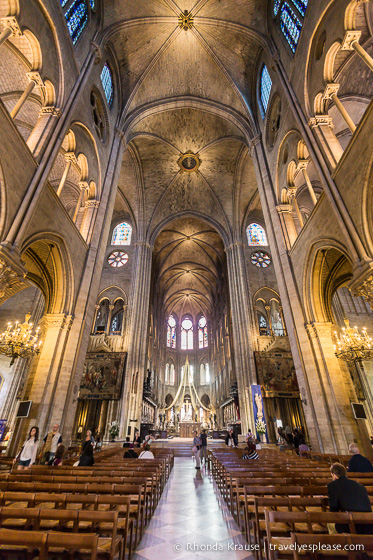
Tips for Visiting Notre-Dame de Paris
Location: Notre-Dame is on the eastern half of Ile de la Cite in the fourth arrondissement.
Getting There: Notre- Dame Cathedral can easily be reached by public transportation.
- Metro: Line 4: Cite or Saint-Michel station, Lines 1 and 11: Hotel de Ville station, Line 10: La Sorbonne or Maubert station, Lines 7, 11 and 14: Chatelet station.
- RER: Line B and C: Saint-Michel Notre-Dame.
Cathedral Opening Hours: The cathedral is open daily year round. Hours are Monday to Friday 7:45 am- 7:00 pm (open late on Thursdays until 10:00 pm) and Saturday and Sunday 8:15 am- 7:30 pm. Confirm current hours here. The last entry is 30 minutes before closing.
- It’s best to visit early in the morning or in the evening to avoid the lines and crowds.
Admission and Reservations: Admission to Notre-Dame Cathedral is free. It is not mandatory to make a reservation to visit Notre-Dame Cathedral, but to avoid waiting in line you can book a time slot for your entrance here. Reservations can be made up to 2 days before your visit or on the day of.
Notre-Dame Bell Towers: The bell towers will remain closed until summer 2025. The following information may not be applicable but will be updated once I can confirm how to access the towers when they reopen.
Access to the Notre-Dame bell towers is at the foot of the North tower (rue du Cloître).
- You can now make an advance reservation to visit the towers. You can pick your time slot via the JeFile app (free from the App Store and Google Play) starting at 7:30 am the day of your visit, or onsite using the ticket terminals. I recommend doing this early in the morning to ensure you get your preferred time. When you enter at your allocated time, you will then pay for your ticket.
- The towers are open 10:00 am- 6:30 pm from April to September and until 5:30 pm from October to March. In July and August on Fridays and Saturdays they are open until 11:00 pm. Last admission is 45 minutes before closing.
- Admission to the bell towers is 10 euro for adults and free for minors under 18. If you have the Paris Museum Pass, admission is free.
- For a great view of the buttresses, take the short bridge behind the cathedral across to Ile St-Louis.
Tours of Notre-Dame Cathedral: Here is a trusted site where you can book guided tours of Notre-Dame.
Information was updated December 2024, but can change without notice.
Accommodations in Paris
For your convenience, here is a list of hotels located near Notre-Dame Cathedral. Please consider booking your Paris accommodations through the included link. It costs nothing extra and helps support this website. Thank you!
More Paris Attractions and Travel Guides
- Where to Stay in Paris- A Guide to the Best Paris Neighbourhoods for Travellers
- Sainte-Chapelle- A Stained Glass Masterpiece
- The Conciergerie- From Palace to Prison
- Romantic Paris- Our Favourite Romantic Things to Do in Paris
